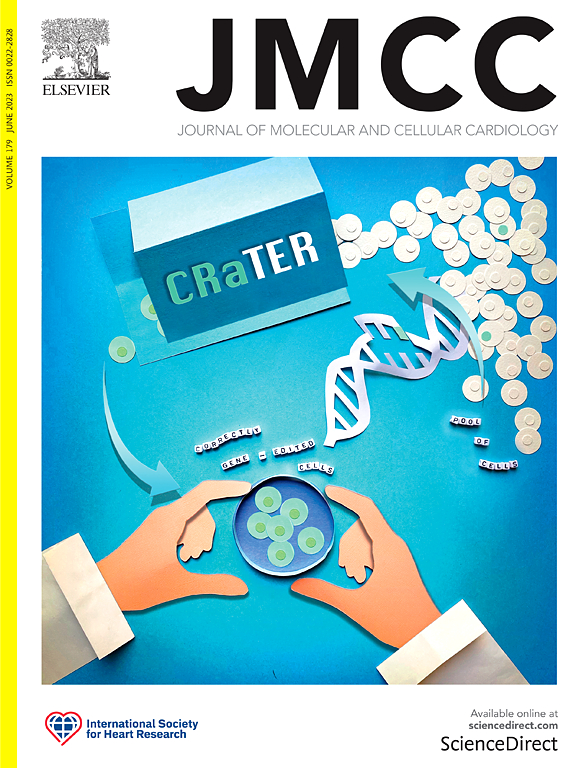内皮细胞CD36介导饮食引起的主动脉僵硬增加
IF 4.7
2区 医学
Q1 CARDIAC & CARDIOVASCULAR SYSTEMS
引用次数: 0
摘要
西方饮食(WD)导致肥胖和胰岛素抵抗的患病率上升,这两者都是动脉硬化和相关心血管疾病的关键危险因素。我们最近发现CD36升高与异位脂质积累增加、全身和组织胰岛素抵抗以及动脉硬化有关。在这里,我们进一步研究了内皮细胞(EC)特异性CD36 (ECCD36)是否参与了wd诱导的主动脉胰岛素抵抗、脂质积累、炎症、纤维化、重塑和相关的主动脉硬化。雌性ECCD36敲除(ECCD36−/−)和野生型(ECCD36+/+)小鼠在6周龄时,分别饲喂西方饮食(WD)或标准食物(CD) 16周。分别用超声(脉冲波速度)和钢丝肌图检查主动脉僵硬度和活动。western blot和定量PCR检测基因表达。分别采用油红O染色和免疫染色检测主动脉脂质含量和主动脉重构。16周的WD增加了主动脉硬化,这与血管胰岛素抵抗和通过磷酸肌肽3-激酶/蛋白激酶b减少胰岛素代谢信号有关。血管胰岛素抵抗和硬化的病理生理变化与哺乳动物雷帕霉素/S6激酶信号靶的激活、脂质紊乱增加、紧密连接相关蛋白occludin减少、促炎反应增加和主动脉重塑有关。在饲喂WD的ECCD36 - / -小鼠中,这些异常被减弱。这些研究结果表明,在致肥胖的西方饮食(WD)下,ECCD36信号的升高有助于主动脉胰岛素抵抗、脂质积累增加、内皮通透性增加和促炎反应、纤维化、血管重塑以及随之而来的主动脉硬化。本文章由计算机程序翻译,如有差异,请以英文原文为准。

Endothelial CD36 mediates diet-induced increases in aortic stiffness
A Western diet (WD) contributes to the rising prevalence of obesity and insulin resistance, both of which are key risk factors for arterial stiffening and related cardiovascular diseases. We recently found that elevated CD36 is associated with increased ectopic lipid accumulation, systemic and tissue insulin resistance, and arterial stiffening. Here, we further examined whether endothelial cell (EC) specific CD36 (ECCD36) participates in WD-induced aortic insulin resistance, lipid accumulation, inflammation, fibrosis, remodeling, and associated aortic stiffening. Female ECCD36 knockout (ECCD36−/−) and wild-type (ECCD36+/+) mice, at six weeks of age, were fed either a Western diet (WD) or a standard chow diet (CD) for 16 weeks. Aortic stiffness and activity were investigated by ultrasound (pulse wave velocity) and wire myography, respectively. Gene expression was monitored by western blot and quantitative PCR. Lipid content and aortic remodeling were explored by Oil red O staining and immunostaining, respectively. 16 weeks of WD increased aortic stiffening that was associated with vascular insulin resistance and reduced insulin metabolic signaling via phosphoinositide 3-kinases/protein kinase B. The pathophysiological changes in vascular insulin resistance and stiffening were associated with activation of mammalian target of rapamycin/S6 kinase signaling, increased lipid disorders, decreased tight junction-associated protein occludin, and increased proinflammatory response, and aortic remodeling. These abnormalities were blunted in ECCD36−/− mice fed a WD. These findings suggest that under an obesogenic Western diet (WD), heightened ECCD36 signaling contributes to aortic insulin resistance, increased lipid accumulation, increased endothelial permeability and proinflammatory responses, fibrosis, vascular remodeling, and consequent aortic stiffening.
求助全文
通过发布文献求助,成功后即可免费获取论文全文。
去求助
来源期刊
CiteScore
10.70
自引率
0.00%
发文量
171
审稿时长
42 days
期刊介绍:
The Journal of Molecular and Cellular Cardiology publishes work advancing knowledge of the mechanisms responsible for both normal and diseased cardiovascular function. To this end papers are published in all relevant areas. These include (but are not limited to): structural biology; genetics; proteomics; morphology; stem cells; molecular biology; metabolism; biophysics; bioengineering; computational modeling and systems analysis; electrophysiology; pharmacology and physiology. Papers are encouraged with both basic and translational approaches. The journal is directed not only to basic scientists but also to clinical cardiologists who wish to follow the rapidly advancing frontiers of basic knowledge of the heart and circulation.

 求助内容:
求助内容: 应助结果提醒方式:
应助结果提醒方式:


